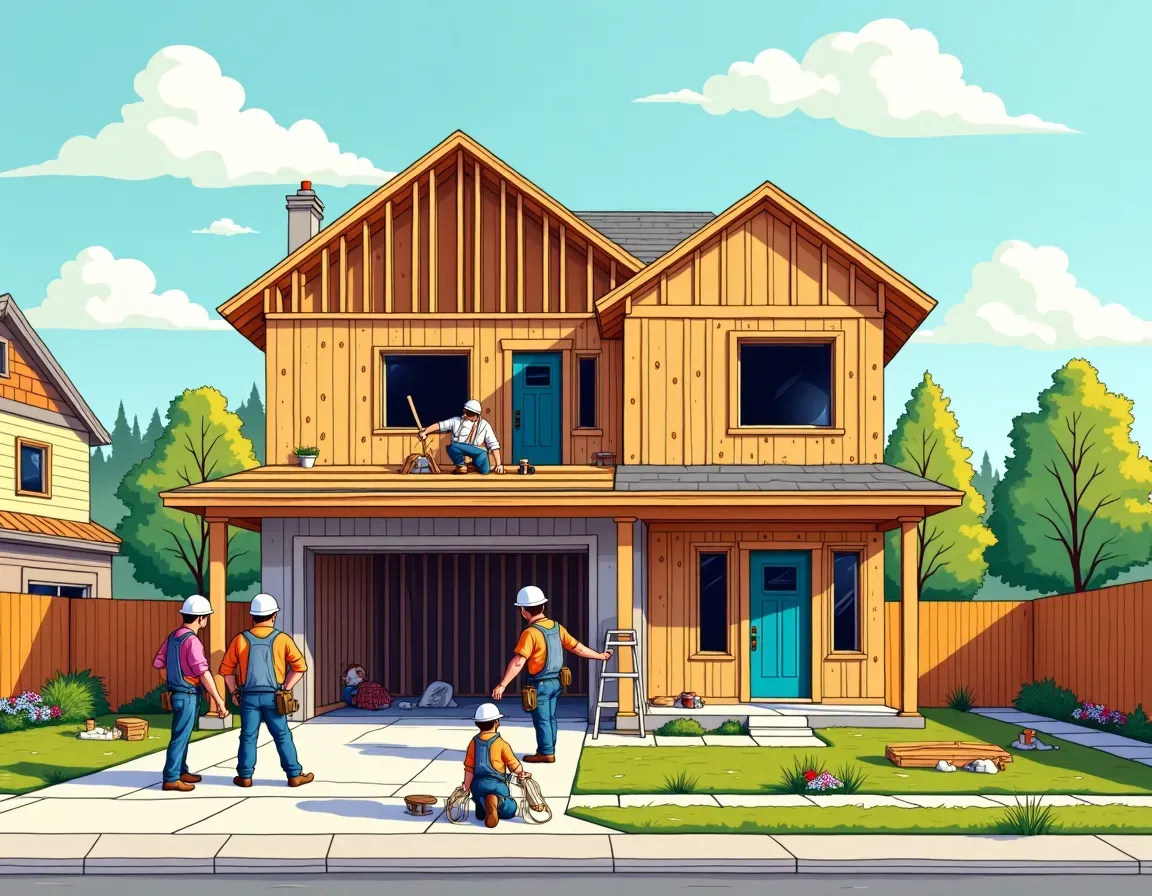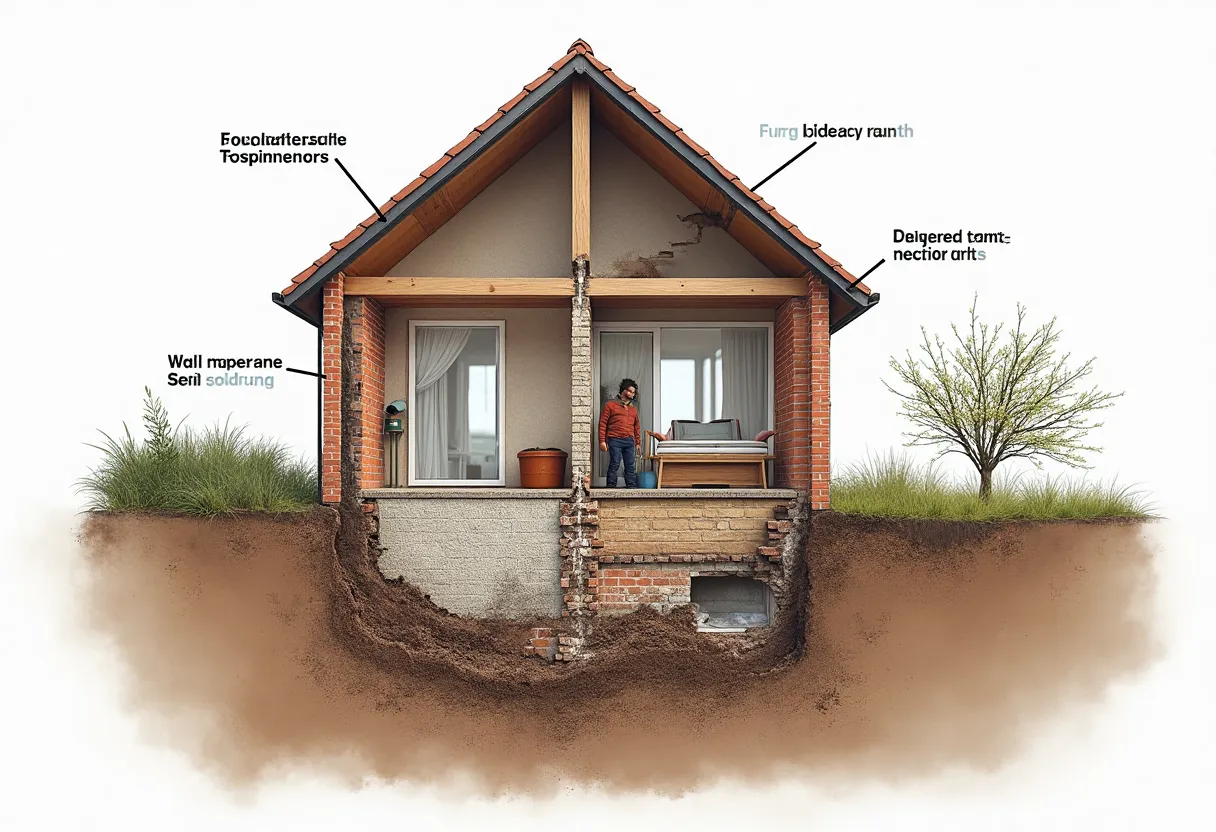So You Want to Build a Family House in 2025? Here's What I've Learned

Look, I'm not going to pretend building a house is easy. It's not. It's a beautiful nightmare of decisions, compromises, and unexpected costs that somehow—against all odds—results in a place you'll eventually call home. After helping my brother through his build last year and going through my own renovation nightmare in 2023 (don't get me started on supply chain issues), I've collected some hard-won wisdom that might save you a headache or twelve.
What You Actually Need to Know About Building a House
-Figure out what you really want before talking to professionals
- Budget way more than you think you need (then add 20%)
- Find builders and architects you actually like as people
- Plan absolutely everything before breaking ground
- Stay involved during construction (things WILL go wrong)
- Building a House: The Rollercoaster You Voluntarily Board
OK so you're really doing this? Building from scratch in 2025 when construction costs are... well, let's just say they're not what they were when our parents built. But there's something special about creating a place that's truly yours—where no previous owner's questionable design choices haunt you from behind the walls.
I remember walking through my friend Ellie's newly built home last September. She pointed out all these thoughtful details—a hidden pantry behind the kitchen, outlets positioned exactly where she needed them, a mudroom designed specifically for her three very muddy boys. "This is why we suffered through 16 months of construction hell," she said, looking simultaneously exhausted and proud.
That's what you're signing up for: the chance to create something perfectly tailored to how you live, balanced against the reality of dust, delays, and decisions. So. Many. Decisions.
Let me break down what you're in for:
1. Figure Out What You Actually Want

I made something like this on the back of a pizza box when we started planning. Not quite this neat, but you get the idea.
Before you talk to a single professional, spend some serious time thinking about how you actually live versus how you think you should live. My sister-in-law insisted on a formal dining room she's used exactly twice in three years. Meanwhile, she wishes she'd made the laundry room bigger since it's where she spends half her Sunday afternoons.
What do your mornings look like? Where do you spend most of your time? Do you cook elaborate meals or are you more of a microwave family? No judgment—I once reheated pizza for dinner three nights in a row during a particularly brutal work week. But knowing yourself prevents expensive mistakes.
Think about the future too. My neighbors built their dream home with a first-floor master suite because—as they told me while we shared a bottle of wine on their gorgeous patio—"We're not getting any younger, and I refuse to navigate stairs with a broken hip at 75." Smart.
Beyond rooms and layout, consider what materials and features matter to you personally. I've become slightly obsessed with natural light after living in a cave-like apartment for years. My cousin Mark couldn't care less about windows, but invested in soundproofing because he works nights and sleeps during the day. These personal priorities matter more than whatever's trending on home design shows.
Oh, and sustainable features? They used to be a luxury upgrade, but now they're becoming standard—and for good reason. My electric bills dropped almost 35% after installing proper insulation and energy-efficient windows during our renovation. The upfront cost made me wince, but I'm thanking myself every month now.
Wait, I should've mentioned this earlier—take photos of spaces you love! Whether it's your friend's kitchen layout or a random bathroom at that boutique hotel you stayed at last summer. Having visual references helps tremendously when trying to communicate what you want to designers. Words like "modern" or "cozy" mean wildly different things to different people.
2. Money Stuff (The Part Nobody Likes Talking About)
I'm just going to say it: whatever budget you have in mind, it's probably not enough. I don't mean to be depressing, but nearly everyone I know who's built a house—myself included with just a major renovation—has gone over budget. Sometimes by a little, sometimes by... well, let's just say my friend Dave had to postpone his kitchen renovation for a year after blowing through his house-building contingency fund.
Here's what goes into the budget:
Land costs vary wildly—from $3,000 for a patch of nowhere to $150,000+ for something in a desirable area. We looked at a gorgeous lot in Portland that was $175K for basically a quarter acre. Insanity! But location matters hugely for resale value (if you ever plan to move) and your daily quality of life.
Site preparation isn't sexy, but it's necessary and expensive. Clearing land, grading, running utilities... all that invisible work adds up to around $35,000 before you've even poured a foundation. My brother hit unexpected rock during excavation and—surprise!—needed to spend an extra $7,000 on specialized equipment. Fun times.
The actual house construction averages around $308,588 nationally, though that number feels kinda useless since it varies so dramatically by region. In my area (Northeast), you're looking at closer to $185-$220 per square foot for standard construction, not the $150 national average. California friends? I'm sorry, it's even worse for you.
Here's a rough breakdown:
| Cost Category | Estimated Range | What My Brother Actually Spent |
|---|---|---|
| Land Purchase | $50,000 - $100,000 | $87,500 |
| Land Development | $30,000 - $60,000 | $43,200 + $7,000 (rock removal) |
| Construction Costs | ~$308,588 | $342,650 |
| Permits & Inspections | $13,367 - $16,367 | $15,890 |
| Sustainable Features | $6,172 - $30,859 | $22,475 |
| Utility Connections | ~$7,500 | $6,800 |
| Total | $424,094 - $544,919 | $525,515 |
And that table doesn't include furniture, window treatments, landscaping, or the therapy you might need after making 10,000 decisions under pressure. I'm only half-joking about the therapy.
The permitting process deserves special mention because it varies wildly depending on where you live. My town is relatively builder-friendly with a 3-4 week turnaround on permits. My cousin in the Bay Area waited FOUR MONTHS for permit approval. That's four months of paying for land you can't build on yet. Budget for these timing issues.
One thing I've learned: don't cheap out on the things that are expensive to fix later. Foundation, roof, insulation, windows—get these right the first time. You can always upgrade countertops or light fixtures down the road, but nobody wants to retrofit foundation issues.
3. Assembling Your Dream Team (or at least people who won't make you cry)
Finding the right professionals isn't just about comparing bids—though that matters too. It's about finding people you can actually communicate with during what will be a long and occasionally stressful process.
When we renovated, we interviewed three contractors. The first was clearly competent but talked over me constantly. The second had the lowest bid but couldn't give straight answers about his timeline. We went with the third even though he was 8% more expensive, because he actually listened to our concerns and—this was key—explained things clearly without condescension.
Your architectural team translates your jumbled ideas into coherent plans. Chemistry matters here! My friend Jamie hired an architect with an impressive portfolio but zero interest in how Jamie's family actually lived. The result? A gorgeous house that doesn't work for them at all. They have a stunning open concept kitchen-living area, but Jamie works from home and can't take calls because there's no sound barrier from the kids' play area. An architect who asked better questions would have caught this.
Check references, obviously. But don't just ask "Were you satisfied?" Ask specific questions like:
- "How did they handle unexpected problems?"
- "Were they responsive to your calls/emails?"
- "Did the final cost match the estimate?"
- "What's the one thing you wish they'd done differently?"
And for God's sake, make sure everyone is properly licensed and insured. My neighbor tried to save money with a handyman-type builder for their addition. When he accidentally took out a water line serving three houses on the block... well, let's just say insurance becomes really important really fast.
The best working relationship has clear communication boundaries. We had a standing weekly meeting with our contractor, plus a shared document where we could list non-urgent questions. This prevented both the "I'm constantly bugging him" problem and the "I can never reach him" problem.
Actually, I just remembered something important—check how your potential team members treat their subcontractors. Our contractor had worked with the same electrician and plumber for over a decade. That continuity was a good sign. When teams work together regularly, there's less finger-pointing and more problem-solving.
4. The Planning Stage (or "Why is this taking so long when nothing is happening yet?")
The planning stage feels eternal. You're excited to build, you've got your team, and then... paperwork and meetings and more paperwork. This stage typically takes 1-3 months, but honestly, it often stretches longer.
I've found this is where most people get impatient and start making rushed decisions just to move things along. Resist this urge! Changes on paper cost virtually nothing. Changes once construction starts? Budget-killers.
Your architect will create preliminary designs based on your discussions. These will be revised. Then revised again. Then probably once more. It's normal. We went through four iterations of our renovation plans before landing on the final design. The last version was dramatically better than the first because each round of feedback refined our thinking.
During this phase, you'll also deal with:
- Zoning requirements and building codes (boring but non-negotiable)
- Structural engineering considerations (especially important in areas with specific weather challenges)
- Material selections (so. many. options.)
- Fixture choices (did you know there are approximately 8 billion types of bathroom faucets?)
- Finishes (paint, tile, flooring, countertops...)
It helps to create a decision-tracking system. We used a shared spreadsheet with columns for item, options, decision deadline, status, and notes. Otherwise, you'll find yourself in a panic at 11pm trying to remember whether you selected the brushed nickel or matte black doorknobs. Not that I've done that...
One thing I wish someone had told me: collect all your inspiration and decisions in one place. We had ideas scattered across Pinterest, magazine clippings, and random phone photos. It made communicating our vision needlessly complicated.
Oh—and get EVERYTHING in writing. Verbal agreements are worthless when memories differ six months later. Our contract specified not just costs but brands, models, and specific materials. This saved us when our contractor initially installed a similar-but-different (and cheaper) bathroom vent than what we'd specified.
5. Actually Building the Darn Thing
FINALLY! Construction begins and things start happening! This phase is simultaneously exciting (watching walls go up!) and frustrating (why is no one on site today?).
Site preparation and foundation work might not look impressive, but they're critical. Our neighbors had drainage issues for YEARS because their builder took shortcuts during this phase. The foundation is literally what everything else rests on—make sure it's done right.
Framing is when your house starts looking like a house. Walking through the framed rooms gives you a much better sense of space than blueprints ever could. This is often when people realize they want to make changes—which is fine, but remember that changes now cost money and time.
My friend realized during framing that her kitchen window would look directly into her neighbor's bathroom. Changing it meant modifying the plans and getting new permits—a $3,400 expense and two-week delay. Worth it to not watch her neighbor brush his teeth every morning, but still painful.
The rough-in phase for electrical, plumbing, and HVAC systems is when all the hidden infrastructures get installed. Mark's advice here was golden: take photos of every wall before the drywall goes up. Having a record of exactly where wires and pipes are located saves massive headaches later when you want to hang something heavy or drill into a wall.
I get a lot of questions about timing. How long does building a house take? The honest answer is: longer than planned. Supply chain issues, weather delays, inspection scheduling, and contractor juggling multiple jobs all impact timing. My brother's 10-month build timeline turned into 13 months. That's actually not bad—I've heard horror stories of two-year builds.
Inspections happen throughout the process, not just at the end. Failed inspections mean fixes and re-inspections, which mean delays. Our insulation failed inspection because the contractor's crew missed a small area in the attic. Just a two-day delay, but multiply these small hiccups across a project...
Interior finishes transform the house from a construction site to a home. This is when your material and color choices become reality. It's also when budget fatigue often kicks in. By this point, you've probably already dealt with unexpected expenses, so the temptation to cheap out on finishes is strong. Resist where you can—these are the elements you'll interact with daily.
Final walkthrough is critical. Bring a notepad and sticky notes. Mark EVERYTHING you notice, from paint touch-ups to crooked switch plates. This creates your "punch list" of items the builder needs to address before final payment. Be thorough but reasonable—minor imperfections are normal, but functional issues aren't acceptable.
What I Wish I'd Known Before Starting
Looking back at my own renovation and my brother's build, here are things I wish we'd known from the start:
- Decision fatigue is real. By month three, you'll be saying "whatever you think is fine" to questions about things you actually care about. Plan for this by prioritizing decisions. What matters most to you? Focus your energy there.
- Your timeline needs padding. Whatever timeline your builder gives you, add 25%. If they say 10 months, mentally prepare for 12-13. Best case, you're pleasantly surprised. Worst case, you're prepared.
- Site visits matter. My brother caught a major window placement issue because he visited regularly. His master bedroom window was being framed 18 inches lower than planned, which would have meant lying in bed and staring at a window frame instead of the mountain view.
- Local material sources reduce delays. Imported tile is gorgeous but can take months to arrive if there's a backorder. Same with specialized fixtures or custom items. Ask about lead times before falling in love with materials.
- Neighbors matter during construction. My brother brought gift baskets to the immediate neighbors before construction started, acknowledging the upcoming noise and mess. This goodwill paid off when they needed to temporarily move a fence during foundation work.
- The cheapest bid usually costs more in the end. The lowest bidder often excludes things other contractors include, misses complications others foresee, or cuts corners you'll pay to fix later.
- You'll go over budget. Just accept this now. The only question is by how much. Having a contingency fund isn't optional—it's essential.
The Bottom Line
Building a house is hard. It's stressful, expensive, and full of compromises. There will be days you question your sanity for starting this project.
But then one day, you'll stand in your completed home—a space designed specifically for how you live, filled with choices you made—and it will feel like magic. My brother texted me a month after moving in: "Drinking coffee in the breakfast nook we designed, watching the kids play in the backyard through the windows we positioned just right. Worth every headache."
Despite all my cautionary tales, I'd do it again in a heartbeat. Just... maybe not tomorrow.
Sources That Actually Helped Me
I've read approximately one million articles about home building. These were the ones that provided information I actually used:
- Quicken Loans - How Much Does it Cost to Build a House - Their breakdown by category was the most realistic I found.
- Angi - Site Development Costs - Helpful for understanding those invisible early costs.
- VMS Consultants - Green Buildings - Great analysis of the cost/benefit of sustainable features.
- Construct Elements - Custom Home Building Budget - Covers all those little line items you might forget.
- NAHB - Cost of Constructing a Home - Good for overall trends and averages.
- Built Right Homes - Building Team - Practical advice on choosing contractors.
- Hedgefield - Home Building Process - The most honest timeline explanation I found.
- Northrop Realty - Construction Stages - Great visual guide to what happens when.
- Value Built Homes - Construction Stages - Helpful for understanding what to expect at each phase.
- New Home Source - Building Process Guide - Comprehensive overview with realistic expectations.
There are tons more, but honestly, talking to friends who've actually built recently was more helpful than most online resources. Nothing beats first-hand experience and local knowledge.
If you're serious about building, start a conversation with someone in your area who completed a build in the last 1-2 years. Buy them coffee and listen to their war stories. Their insights about local contractors, permit processes, and regional challenges will be worth more than any article I could link you to.
Good luck! You're gonna need it—but you'll also end up with something amazing if you stick with it.



